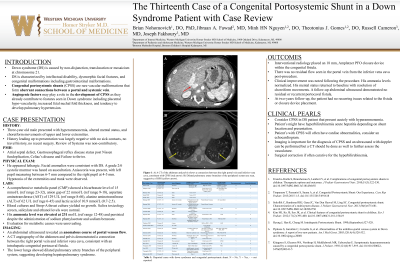Back


Poster Session A - Sunday Afternoon
Category: Pediatrics
A0608 - The Thirteenth Case of a Congenital Portosystemic Shunt in a Down Syndrome Patient
Sunday, October 23, 2022
5:00 PM – 7:00 PM ET
Location: Crown Ballroom

Has Audio

Brian Nohomovich, DO, PhD
Western Michigan University
Kalamazoo, MI
Presenting Author(s)
Brian Nohomovich, DO, PhD, Jibraan Fawad, MD, Minh Nguyen, DO, MS, Theotonius Gomes, DO, Joseph Fakhoury, MD, Russell Cameron, MD
Western Michigan University, Kalamazoo, MI
Introduction: Down syndrome is caused by non-disjunction (Trisomy 21), translocation, or mosaicism at chromosome 21 and is characterized by intellectual disability, dysmorphic facial features, and congenital malformations, including gastrointestinal abnormalities. Congenital portosystemic shunts (CPSS) are rare vascular malformations that form aberrant connections between a portal and systemic vein within the liver, diverting portal flow from the liver to the systemic venous system. The etiology of these malformations is poorly understood. Some hypotheses suggest dysfunction in angiogenic factors, which may play a role in the development of features already seen in Down syndrome, including placental hypo-vascularity, increased fetal nuchal fold thickness, and a tendency to develop pulmonary hypertension. There is an increasing appreciation of congenital portosystemic shunts in Down syndrome patients.
Case Description/Methods: Our patient presented with hyperammonemia, altered mental status, and choreiform movements. A computed tomography angiography of the abdomen and pelvis demonstrated a connection between the right portal vein and inferior vena cava, consistent with an intrahepatic congenital portocaval fistula. The lower lungs showed dilated pulmonary artery branches of the peripheral system, suggesting developing hepatopulmonary syndrome (HPS). Interventional radiology placed an 18 mm, Amplatzer PFO closure device within the congenital fistula. No residual flow was seen in the portal vein from the inferior vena cava post-procedure. Clinical improvement was noted following the procedure. His ammonia levels normalized. His mental status returned to baseline with the resolution of choreiform movements. A follow-up abdominal ultrasound demonstrated no residual or recurrent portocaval fistula. At the two-year follow-up, the patient had no recurring issues related to the fistula or closure device placement.
Discussion: Herein we describe the third case of a CPSS in a Down Syndrome patient and the 13th overall case of a CPSS with our approach to work up and treatment highlighted in the context of a literature review of similar cases.
Disclosures:
Brian Nohomovich, DO, PhD, Jibraan Fawad, MD, Minh Nguyen, DO, MS, Theotonius Gomes, DO, Joseph Fakhoury, MD, Russell Cameron, MD. A0608 - The Thirteenth Case of a Congenital Portosystemic Shunt in a Down Syndrome Patient, ACG 2022 Annual Scientific Meeting Abstracts. Charlotte, NC: American College of Gastroenterology.
Western Michigan University, Kalamazoo, MI
Introduction: Down syndrome is caused by non-disjunction (Trisomy 21), translocation, or mosaicism at chromosome 21 and is characterized by intellectual disability, dysmorphic facial features, and congenital malformations, including gastrointestinal abnormalities. Congenital portosystemic shunts (CPSS) are rare vascular malformations that form aberrant connections between a portal and systemic vein within the liver, diverting portal flow from the liver to the systemic venous system. The etiology of these malformations is poorly understood. Some hypotheses suggest dysfunction in angiogenic factors, which may play a role in the development of features already seen in Down syndrome, including placental hypo-vascularity, increased fetal nuchal fold thickness, and a tendency to develop pulmonary hypertension. There is an increasing appreciation of congenital portosystemic shunts in Down syndrome patients.
Case Description/Methods: Our patient presented with hyperammonemia, altered mental status, and choreiform movements. A computed tomography angiography of the abdomen and pelvis demonstrated a connection between the right portal vein and inferior vena cava, consistent with an intrahepatic congenital portocaval fistula. The lower lungs showed dilated pulmonary artery branches of the peripheral system, suggesting developing hepatopulmonary syndrome (HPS). Interventional radiology placed an 18 mm, Amplatzer PFO closure device within the congenital fistula. No residual flow was seen in the portal vein from the inferior vena cava post-procedure. Clinical improvement was noted following the procedure. His ammonia levels normalized. His mental status returned to baseline with the resolution of choreiform movements. A follow-up abdominal ultrasound demonstrated no residual or recurrent portocaval fistula. At the two-year follow-up, the patient had no recurring issues related to the fistula or closure device placement.
Discussion: Herein we describe the third case of a CPSS in a Down Syndrome patient and the 13th overall case of a CPSS with our approach to work up and treatment highlighted in the context of a literature review of similar cases.
Disclosures:
Brian Nohomovich indicated no relevant financial relationships.
Jibraan Fawad indicated no relevant financial relationships.
Minh Nguyen indicated no relevant financial relationships.
Theotonius Gomes indicated no relevant financial relationships.
Joseph Fakhoury indicated no relevant financial relationships.
Russell Cameron indicated no relevant financial relationships.
Brian Nohomovich, DO, PhD, Jibraan Fawad, MD, Minh Nguyen, DO, MS, Theotonius Gomes, DO, Joseph Fakhoury, MD, Russell Cameron, MD. A0608 - The Thirteenth Case of a Congenital Portosystemic Shunt in a Down Syndrome Patient, ACG 2022 Annual Scientific Meeting Abstracts. Charlotte, NC: American College of Gastroenterology.
